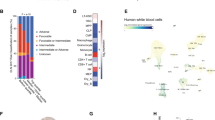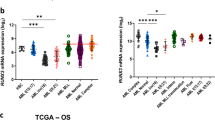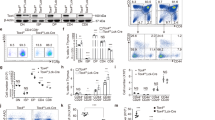Abstract
Tight regulation of transcription factors, such as PU.1, is crucial for generation of all hematopoietic lineages. We previously reported that mice with a deletion of an upstream regulatory element (URE) of the gene encoding PU.1 (Sfpi1) developed acute myeloid leukemia. Here we show that the URE has an essential role in orchestrating the dynamic PU.1 expression pattern required for lymphoid development and tumor suppression. URE deletion ablated B2 cells but stimulated growth of B1 cells in mice. The URE was a PU.1 enhancer in B cells but a repressor in T cell precursors. TCF transcription factors coordinated this repressor function and linked PU.1 to Wnt signaling. Failure of appropriate PU.1 repression in T cell progenitors with URE deletion disrupted differentiation and induced thymic transformation. Genome-wide DNA methylation assessment showed that epigenetic silencing of selective tumor suppressor genes completed PU.1-initiated transformation of lymphoid progenitors with URE deletion. These results elucidate how a single transcription factor, PU.1, through the cell context–specific activity of a key cis-regulatory element, affects the development of multiple cell lineages and can induce cancer.
This is a preview of subscription content, access via your institution
Access options
Subscribe to this journal
Receive 12 print issues and online access
$209.00 per year
only $17.42 per issue
Buy this article
- Purchase on Springer Link
- Instant access to full article PDF
Prices may be subject to local taxes which are calculated during checkout







Similar content being viewed by others
References
Kondo, M., Weissman, I.L. & Akashi, K. Identification of clonogenic common lymphoid progenitors in mouse bone marrow. Cell 91, 661–672 (1997).
Rothstein, T.L. Cutting edge commentary: two B-1 or not to be one. J. Immunol. 168, 4257–4261 (2002).
Berland, R. & Wortis, H.H. Origins and functions of B-1 cells with notes on the role of CD5. Annu. Rev. Immunol. 20, 253–300 (2002).
Herzenberg, L.A. B-1 cells: the lineage question revisited. Immunol. Rev. 175, 9–22 (2000).
Tenen, D.G., Hromas, R., Licht, J.D. & Zhang, D.E. Transcription factors, normal myeloid development, and leukemia. Blood 90, 489–519 (1997).
Orkin, S.H. Diversification of haematopoietic stem cells to specific lineages. Nat. Rev. Genet. 1, 57–64 (2000).
Moreau-Gachelin, F., Tavitian, A. & Tambourin, P. Spi-1 is a putative oncogene in virally induced murine erythroleukaemias. Nature 331, 277–280 (1988).
Moreau-Gachelin, F. et al. Spi-1/PU.1 transgenic mice develop multistep erythroleukemias. Mol. Cell. Biol. 16, 2453–2463 (1996).
Scott, E.W., Simon, M.C., Anastasi, J. & Singh, H. Requirement of transcription factor PU.1 in the development of multiple hematopoietic lineages. Science 265, 1573–1577 (1994).
McKercher, S.R. et al. Targeted disruption of the PU.1 gene results in multiple hematopoietic abnormalities. EMBO J. 15, 5647–5658 (1996).
Kim, H.G. et al. The ETS-family transcription factor, PU.1, is necessary for the maintenance of fetal liver hematopoietic stem cells. Blood 104, 3894–3900 (2004).
Iwasaki, H. et al. Distinctive and indispensable roles of PU.1 in maintenance of hematopoietic stem cells and their differentiation. Blood 106, 1590–1600 (2005).
Anderson, M.K., Weiss, A.H., Hernandez-Hoyos, G., Dionne, C.J. & Rothenberg, E.V. Constitutive expression of PU.1 in fetal hematopoietic progenitors blocks T cell development at the pro-T cell stage. Immunity 16, 285–296 (2002).
DeKoter, R.P. & Singh, H. Regulation of B lymphocyte and macrophage development by graded expression of PU.1. Science 288, 1439–1441 (2000).
Dahl, R. et al. Regulation of macrophage and neutrophil cell fates by the PU.1:C/EBPalpha ratio and granulocyte colony-stimulating factor. Nat. Immunol. 4, 1029–1036 (2003).
Rosenbauer, F. et al. Acute myeloid leukemia induced by graded reduction of a lineage-specific transcription factor, PU.1. Nat. Genet. 36, 624–630 (2004).
Rosenbauer, F., Koschmieder, S., Steidl, U. & Tenen, D.G. Effect of transcription factor concentrations on leukemic stem cells. Blood 106, 1519–1524 (2005).
Li, Y. et al. Regulation of the PU.1 gene by distal elements. Blood 98, 2958–2965 (2001).
Okuno, Y. et al. Potential autoregulation of transcription factor PU.1 by an upstream regulatory element. Mol. Cell. Biol. 25, 2832–2845 (2005).
Rodriguez, C.I. et al. High-efficiency deleter mice show that FLPe is an alternative to Cre-loxP. Nat. Genet. 25, 139–140 (2000).
Morris, D.L. & Rothstein, T.L. Abnormal transcription factor induction through the surface immunoglobulin M receptor of B-1 lymphocytes. J. Exp. Med. 177, 857–861 (1993).
Boes, M. et al. Enhanced B-1 cell development, but impaired IgG antibody responses in mice deficient in secreted IgM. J. Immunol. 160, 4776–4787 (1998).
Stall, A.M. et al. Ly-1 B-cell clones similar to human chronic lymphocytic leukemias routinely develop in older normal mice and young autoimmune (New Zealand Black-related) animals. Proc. Natl. Acad. Sci. USA 85, 7312–7316 (1988).
Ceredig, R. & Rolink, T. A positive look at double-negative thymocytes. Nat. Rev. Immunol. 2, 888–897 (2002).
Balciunaite, G., Ceredig, R. & Rolink, A.G. The earliest subpopulation of mouse thymocytes contains potent T, significant macrophage, and natural killer cell but no B-lymphocyte potential. Blood 105, 1930–1936 (2005).
Tetsu, O. & McCormick, F. Beta-catenin regulates expression of cyclin D1 in colon carcinoma cells. Nature 398, 422–426 (1999).
van de, W.M., de Lau, W. & Clevers, H. WNT signaling and lymphocyte development. Cell 109 Suppl, S13–S19 (2002).
Amaravadi, L. & Klemsz, M.J. DNA methylation and chromatin structure regulate PU.1 expression. DNA Cell Biol. 18, 875–884 (1999).
Holtschke, T. et al. Immunodeficiency and chronic myelogenous leukemia-like syndrome in mice with a targeted mutation of the ICSBP gene. Cell 87, 307–317 (1996).
Watanabe, S. et al. Accessibility to tissue-specific genes from methylation profiles of mouse brain genomic DNA. Electrophoresis 16, 218–226 (1995).
Yu, L. et al. Global assessment of promoter methylation in a mouse model of cancer identifies ID4 as a putative tumor-suppressor gene in human leukemia. Nat. Genet. 37, 265–274 (2005).
Yu, L. et al. A NotI-EcoRV promoter library for studies of genetic and epigenetic alterations in mouse models of human malignancies. Genomics 84, 647–660 (2004).
Singh, H., Medina, K.L. & Pongubala, J.M. Gene Regulatory Networks Special Feature: Contingent gene regulatory networks and B cell fate specification. Proc. Natl. Acad. Sci. USA 102, 4949–4953 (2005).
Fischer, G.M. et al. Splenic and peritoneal B-1 cells differ in terms of transcriptional and proliferative features that separate peritoneal B-1 from splenic B-2 cells. Cell. Immunol. 213, 62–71 (2001).
Caligaris-Cappio, F., Gobbi, M., Bofill, M. & Janossy, G. Infrequent normal B lymphocytes express features of B-chronic lymphocytic leukemia. J. Exp. Med. 155, 623–628 (1982).
Dakic, A. et al. PU.1 regulates the commitment of adult hematopoietic progenitors and restricts granulopoiesis. J. Exp. Med. 201, 1487–1502 (2005).
Schilham, M.W. et al. Critical involvement of Tcf-1 in expansion of thymocytes. J. Immunol. 161, 3984–3991 (1998).
Boxer, R.B., Jang, J.W., Sintasath, L. & Chodosh, L.A. Lack of sustained regression of c-MYC-induced mammary adenocarcinomas following brief or prolonged MYC inactivation. Cancer Cell 6, 577–586 (2004).
Costello, J.F. et al. Aberrant CpG-island methylation has non-random and tumour-type-specific patterns. Nat. Genet. 24, 132–138 (2000).
Suzuki, M. et al. Site-specific DNA methylation by a complex of PU.1 and Dnmt3a/b. Oncogene (in the press).
Chan, A.S. et al. Downregulation of ID4 by promoter hypermethylation in gastric adenocarcinoma. Oncogene 22, 6946–6953 (2003).
Andres-Barquin, P.J., Hernandez, M.C. & Israel, M.A. Id4 expression induces apoptosis in astrocytic cultures and is down-regulated by activation of the cAMP-dependent signal transduction pathway. Exp. Cell Res. 247, 347–355 (1999).
Hanson, P., Mathews, V., Marrus, S.H. & Graubert, T.A. Enhanced green fluorescent protein targeted to the Sca-1 (Ly-6A) locus in transgenic mice results in efficient marking of hematopoietic stem cells in vivo. Exp. Hematol. 31, 159–167 (2003).
Harada, N. et al. Intestinal polyposis in mice with a dominant stable mutation of the beta-catenin gene. EMBO J. 18, 5931–5942 (1999).
Schmitt, T.M. & Zuniga-Pflucker, J.C. Induction of T cell development from hematopoietic progenitor cells by delta-like-1 in vitro. Immunity 17, 749–756 (2002).
Rosenbauer, F. et al. pDP4, a novel glycoprotein secreted by mature granulocytes, is regulated by transcription factor PU.1. Blood 103, 4294–4301 (2004).
Holnthoner, W. et al. Fibroblast growth factor-2 induces Lef/Tcf-dependent transcription in human endothelial cells. J. Biol. Chem. 277, 45847–45853 (2002).
Kobayashi, S. et al. Calpain-mediated X-linked inhibitor of apoptosis degradation in neutrophil apoptosis and its impairment in chronic neutrophilic leukemia. J. Biol. Chem. 277, 33968–33977 (2002).
Reya, T. et al. A role for Wnt signalling in self-renewal of haematopoietic stem cells. Nature 423, 409–414 (2003).
Herman, J.G., Graff, J.R., Myohanen, S., Nelkin, B.D. & Baylin, S.B. Methylation-specific PCR: a novel PCR assay for methylation status of CpG islands. Proc. Natl. Acad. Sci. USA 93, 9821–9826 (1996).
Acknowledgements
We thank K. Martens and K. Geary for their assistance in animal husbandry; T. Dayaram and C. Hetherington for help with the real time PCRs; Y.Z. Wu for help with RLGS analysis; J. Tigges and V. Toxavidis for assistance with multicolor flow cytometry; H. Clevers, R. Grosschedl, T. Reya, H. Singh, G. Nolan and J.C. Zuniga-Pflucker for reagents; and H. Clevers, M. Ye, T. Graf, A. Ebralidze and other members of the laboratory of D.G.T. for discussions and sharing of unpublished information. This work was supported by National Institutes of Health grants to T.L.R., C.P. and D.G.T. and by fellowships from the Lymphoma Research Foundation to F.R., from the American Cancer Society to B.M.O. and from the Dr. Mildred Scheel Foundation for Cancer Research to U.S. and B.H. Immunohistochemical methodology was supported by the Specialized Histopathology Core Lab of the Dana Farber/Harvard Cancer Center.
Author information
Authors and Affiliations
Corresponding authors
Ethics declarations
Competing interests
The authors declare no competing financial interests.
Supplementary information
Supplementary Fig. 1
Reduction of fetal liver B cell progenitors in UREΔ/Δ mice. (PDF 76 kb)
Supplementary Fig. 2
Gating example of GFP+/CFP+ double transduced cells. (PDF 18 kb)
Supplementary Fig. 3
Decreasing Wnt-signaling activity during T cell maturation. (PDF 16 kb)
Supplementary Fig. 4
Lymphomas are transplantable into non-irradiated NOD/SCID recipient mice. (PDF 417 kb)
Supplementary Table 1
Genes identified by cloning lost RLGS fragments (PDF 7 kb)
Supplementary Table 2
Oligonucleotide primers and probes used for real-time RT-PCR. (PDF 8 kb)
Rights and permissions
About this article
Cite this article
Rosenbauer, F., Owens, B., Yu, L. et al. Lymphoid cell growth and transformation are suppressed by a key regulatory element of the gene encoding PU.1. Nat Genet 38, 27–37 (2006). https://doi.org/10.1038/ng1679
Received:
Accepted:
Published:
Issue Date:
DOI: https://doi.org/10.1038/ng1679
This article is cited by
-
Genome-wide identification and characteristic analysis of ETS gene family in blood clam Tegillarca granosa
BMC Genomics (2023)
-
How transcription factors drive choice of the T cell fate
Nature Reviews Immunology (2021)
-
Mutational synergy during leukemia induction remodels chromatin accessibility, histone modifications and three-dimensional DNA topology to alter gene expression
Nature Genetics (2021)
-
Bcl-6 is the nexus transcription factor of T follicular helper cells via repressor-of-repressor circuits
Nature Immunology (2020)
-
The ontogeny of murine B-1a cells
International Journal of Hematology (2020)



